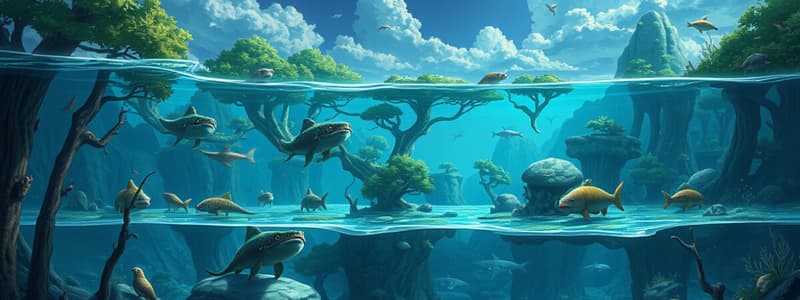Podcast
Questions and Answers
What primarily happens to the energy as it transfers from one trophic level to the next?
What primarily happens to the energy as it transfers from one trophic level to the next?
- It is fully transferred without losses.
- It increases by 10%.
- Only about 10% is passed on, while 90% is lost. (correct)
- It is converted into biomass entirely.
Which trophic level consists of producers that capture energy from the sun?
Which trophic level consists of producers that capture energy from the sun?
- Secondary Consumers
- First Trophic Level (correct)
- Primary Consumers
- Tertiary Consumers
Why do food chains typically not exceed four or five trophic levels?
Why do food chains typically not exceed four or five trophic levels?
- There are not enough species to fill higher levels.
- Predators at higher levels are too large.
- Food chains require complete energy transfer.
- There is insufficient energy available to support additional levels. (correct)
What is the function of decomposers in an ecosystem?
What is the function of decomposers in an ecosystem?
What is represented by an energy pyramid in ecological studies?
What is represented by an energy pyramid in ecological studies?
What does a food web illustrate compared to a simple food chain?
What does a food web illustrate compared to a simple food chain?
How do human activities like pollution affect food chains?
How do human activities like pollution affect food chains?
What is the primary role of producers in a food chain?
What is the primary role of producers in a food chain?
Which of the following organisms would be classified as a secondary consumer?
Which of the following organisms would be classified as a secondary consumer?
Which of the following best defines a quaternary consumer?
Which of the following best defines a quaternary consumer?
Which trophic level is primarily composed of herbivores?
Which trophic level is primarily composed of herbivores?
What is the function of decomposers in an ecosystem?
What is the function of decomposers in an ecosystem?
Which statement distinguishes tertiary consumers from secondary consumers?
Which statement distinguishes tertiary consumers from secondary consumers?
Which of the following is NOT considered a producer?
Which of the following is NOT considered a producer?
What is the primary energy source for producers in a food chain?
What is the primary energy source for producers in a food chain?
Flashcards
Food Chains
Food Chains
Illustrate the flow of energy and nutrients through feeding relationships in an ecosystem.
Producers (Autotrophs)
Producers (Autotrophs)
Organisms that produce their own energy, forming the base of food chains.
Primary Consumers (Herbivores)
Primary Consumers (Herbivores)
Organisms that consume producers (plants).
Secondary Consumers (Carnivores)
Secondary Consumers (Carnivores)
Signup and view all the flashcards
Tertiary Consumers
Tertiary Consumers
Signup and view all the flashcards
Quaternary Consumers
Quaternary Consumers
Signup and view all the flashcards
Decomposers (Detritivores)
Decomposers (Detritivores)
Signup and view all the flashcards
10% Rule
10% Rule
Signup and view all the flashcards
Food Webs
Food Webs
Signup and view all the flashcards
Trophic Levels
Trophic Levels
Signup and view all the flashcards
Energy Pyramid
Energy Pyramid
Signup and view all the flashcards
Biomass Pyramid
Biomass Pyramid
Signup and view all the flashcards
Pyramid of Numbers
Pyramid of Numbers
Signup and view all the flashcards
Bioaccumulation
Bioaccumulation
Signup and view all the flashcards
Human Impact on food chains
Human Impact on food chains
Signup and view all the flashcards
Study Notes
Food Chains and Trophic Levels
- Food chains illustrate the flow of energy and nutrients among organisms in ecosystems through feeding relationships.
- Comprised of different trophic levels, food chains begin with producers and culminate with top predators.
Key Definitions
- Producers (Autotrophs): Form the base of food chains, producing their own energy via photosynthesis (e.g., plants, algae).
- Primary Consumers (Herbivores): Organisms that ingest producers, obtaining energy directly from plants (e.g., deer, rabbits).
- Secondary Consumers (Carnivores): Animals that consume primary consumers for energy, such as snakes eating rabbits.
- Tertiary Consumers: Carnivores that prey on secondary consumers, represented by hawks feeding on snakes.
- Quaternary Consumers: Apex predators without natural threats, essential for ecosystem balance (e.g., lions, eagles).
- Decomposers (Detritivores): Break down dead organisms; critical for nutrient recycling (e.g., bacteria, fungi).
Example of a Simple Food Chain
- Grass → Grasshopper → Frog → Snake → Hawk
- Energy flows from grass (producer) to grasshopper (primary consumer), then to frog (secondary), snake (tertiary), and finally to hawk (quaternary).
Energy Transfer and the 10% Rule
- Energy transfer between trophic levels is inefficient; about 10% is passed to the next level while 90% is lost mainly as heat.
- This inefficiency limits food chains to about four or five trophic levels.
Food Webs
- Food webs represent more complicated interactions within ecosystems, illustrating multiple feeding relationships.
- Organisms may occupy various trophic levels due to varied diets, clarifying the interconnected nature of ecosystems.
Trophic Levels
- First Level: Producers, capturing solar energy.
- Second Level: Primary consumers, herbivores consuming producers.
- Third Level: Secondary consumers, carnivores eating herbivores.
- Fourth Level: Tertiary consumers, carnivores preying on other carnivores.
- Decomposers, while vital, are less defined in specific trophic levels but contribute to nutrient cycling.
Energy Pyramids
- Energy Pyramid: Visualizes energy availability at each trophic level; energy decreases significantly at higher levels.
- Biomass Pyramid: Represents the total mass of living matter at each level, similarly decreasing as you ascend.
- Pyramid of Numbers: Depicts organism numbers at each trophic level, usually highest at the base (producers) and declining upward.
Human Impact
- Human activities such as deforestation, overfishing, and pollution disrupt food chains, leading to ecological imbalances.
- Overfishing can drastically reduce key species, causing domino effects throughout food chains.
- Pollution results in bioaccumulation, significantly impacting higher trophic levels and top predators' health.
Conclusion
- Understanding food chains and trophic levels is critical for ecological awareness and conservation efforts.
- Recognizing the energy flow through ecosystems emphasizes the interdependence of organisms and the need to protect natural environments.
Studying That Suits You
Use AI to generate personalized quizzes and flashcards to suit your learning preferences.




